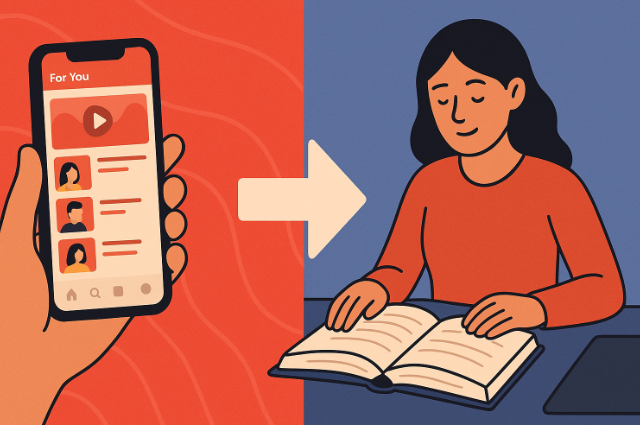
"We’ve trained our brains to crave 15 seconds of dopamine — but what happens when the hit stops working?"
For more than ten years, services such as TikTok, Instagram Reels, or YouTube Shorts have been ruling our televisions, atomizing what we watch into snackable sound bites. But still, there exist cracks. The nature of this stagnation is that there is no growth, declining watch time, and a silent shifting of creators. The onslaught of short-form content that proved to be seemingly unstoppable might be meeting its saturation point in the neural association.
Attention Economy
Attention economy is founded on only one thing, and that is the more you use a platform, the more advertisements it is able to attach to you, and therefore the more revenue a platform can generate. Short-form videos became the crown jewel since they were addictive, infinite to scroll, and did not take much cognitive brainpower.
Neuroscience answers the question of why this went so well, as short-form video is simply a chain of quick dopamine hits Š according to the neuroscience equivalent of the lottery, slot machines. Every swipe is unpredictable; the next clip can be used to laugh at it, to be shocked, to learn something. That concern causes dopamine release into a feedback loop.
However, studies conducted by the University of Hamburg (2024) reveal a paradox, viz., the dopamine-based novelty seeking shows such a diminishing power beside the return curve. There was a 37 percent drop in novelty response in their participants even after six weeks of exposure to high-frequency short stimuli. Put more simply, the brain becomes too excited to be concerned with excitement continuously.
The Numbers Are Turning
Sensor Tower, likewise, reported that, worldwide, TikTok's daily watch-time decreased by 4 percent in Q1 2025: the first-ever decrease since its debut. There are 7% fewer yearly Instagram Reels interchanges in the US. YouTube Shorts is mostly expanding in the emerging markets, but has dried up in North America and Europe.
The creator also does not listen. We spoke with influencer Maya Torres, who has amassed 2.3M followers based on 30-second videos about cooking:
“It feels harder to get the same traction. I used to get half a million views in days — now it takes weeks. People are tired of the same quick hits.”
The Cognitive Fatigue Factor
Cognitive scientists refer to this as an equivalent of acoustic ecology, or the investigation of the influence that sound environments have on human behavior. As with the issue of background noise, wherein the mind continuously becomes tired of listening and shifts focus, the endless proliferation of bite-sized videos can shorten the attention span and result in a decrease in content satisfaction over time.
"We’re seeing what I call 'dopamine debt, '" says Dr. Rina El-Khoury, a neuroscientist at the University of Toronto. "The brain adjusts to constant stimulation, so the threshold for excitement rises. Content that felt thrilling a year ago now barely registers."
The Algorithm’s Role in the Crash
Ironically, it is their algorithms that end up augmenting the rotation on short-form content, which ends up killing it. Machine learning is likely to overservice stable trends and viral sounds because the goal is to maximize watch time, resulting in a monoculture of content. The repeated jokes, dances, and edits are well visible to the viewers, which become tiresome among different creators.
What People Say
One can see an online change. Posts by people deleting apps or exchanging short videos with podcasts, books, or long-form essays abound in threads on Reddit such as the AntiTikTok subreddit r/AntiTikTok or the Digital Detox subreddit r/DigitalDetox.
One viral tweet with 120k likes reads:
“Remember when TikTok was fun? Now it’s just the same 5 jokes on repeat. I’m done.”
Creators are pivoting, too. According to Social Blade, there is a 14 percent rebound in average view time on YouTube long-form. Longer, deeper subscription-based content platforms, Substack and Patreon, both of which favor longer and more considered forms, have seen record sign-ups.
What's The Screen?
The short-form slowdown is not only a platform thing; it is a neurocultural shift. By now, as the mycorrhizal networks in forests are redistributing nutrients due to the overuse of a single tree, so are our concentration levels, endeavoring to find new,
more nourishing types of content after several years of centrifugal excavation by 15-second snacks.
For brands and creators, this means a strategic pivot:
- Diversify formats — combine short clips with deeper, narrative-driven pieces
- Engage curiosity, not just reflex — the future belongs to content that rewards attention, not just grabs it
- Tap into emerging tech — AI-driven interactive stories and spatial audio experiences may become the next engagement frontier
In Dr. El-Khoury’s words:
“Attention is a finite resource. When we spend it wisely, we don’t just consume — we connect, learn, and grow.”
How do you think it will go: the short-form bubble being busted, or yet be reborn?
